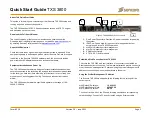
winding and a voltage will be induced in the secondary winding.
A full-wave rectifier will then produce a DC output voltage at
the phase angle detector output.
To eliminate any interaction between voltage and current sam-
ples, the primary winding is tuned to parallel resonance at the
transmitter’s operating frequency to provide a high impedance
between the samples. Switch-selected capacitors and inductors
are used for coarse tuning, and a variable capacitor is used for
fine tuning. The normal/cal switch is provided to resonate the
transformer primary circuit. When the switch is in the “Cal”
position, the current sample is disconnected and the RF voltage
sample will be applied to one end of the transformer primary.
The RF voltage sample (AMPLITUDE) adjustment is a variable
capacitor across the lower half of the capacitive voltage divider.
The RF current (PHASE) adjustment is a capacitor in the parallel
L-C circuit. With the transmitter properly tuned, the detector is
“balanced” by adjusting the RF voltages at opposite ends of the
transformer primary for equal amplitude and phase. When the
detector is balanced, the DC output of the detector should be zero.
H.2.2.2
Antenna VSWR Phase Angle Detector
The Antenna VSWR Phase Angle Detector current sample from
the Output Sample Board enters at J1-1 and is fed to parallel
circuit L12 and C43 through C46. Switch S6 selects the capaci-
tance and L12 is used to adjust the phase.
The Antenna VSWR Phase Angle Detector voltage sample from
the Output Sample Board enters at J1-11 and is fed to amplitude
adjustment C15.
Parallel components C41, C42, L9 and L10, selected by S9, and
capacitor C29 are used to resonate the primary of T1 to the carrier
frequency.
The output signal is rectified by CR7 and CR9 and applied to the
inverting input of U3.
H.2.2.3
Bandpass Filter VSWR Phase Angle Detector
The Bandpass Filter VSWR Phase Angle Detector is also referred
to as the “Internal Phase Angle Detector”.
The Bandpass VSWR Phase Angle Detector current sample from
T9 enters the board at J3-6 is fed to parallel resonant circuit L5
through L8 and C12, C39 and C47. Switch S7 is used to select
coarse values of inductance and capacitance.
The voltage sample input at J1-9 is fed to amplitude adjustment
C16 and parallel capacitors C20 and C28 selected by S2.
Parallel components L2, L3, C3 and C5, selected by S1, and
capacitor C21 are used to resonate the primary of T3 to the carrier
frequency.
The output of T3 is rectified by CR12 and CR16 and applied to
the inverting input of U2.
H.2.2.4
“Phase Angle Detector Null” Meter Indications
The phase angle detector outputs at TP8 and TP9 are DC voltages
which are sent to the LED Board on J2-23 and J2-25. The signals
pass through the LED Board to the Controller where voltage
follower amplifiers are used to drive the front panel MULTIME-
TER. The voltages are metered as “DETECTOR NULL (AN-
TENNA)” and “DETECTOR NULL (FILTER).” These voltages
are also available at the external interface for remote metering.
The “DETECTOR NULL” indications are relative readings. When
phase detectors are properly balanced they should both read zero.
Once the transmitter is tuned, any change in the Bandpass Filter will
cause the DETECTOR NULL (FILTER) reading to increase. The
DETECTOR NULL (ANTENNA) reading will increase if the load
on the transmitter output changes.
H.2.2.5
VSWR Trip Circuits
Because the Antenna VSWR and Bandpass Filter VSWR circuits
are identical except for time constants, only the Antenna VSWR
trip circuit will be discussed.
H.2.2.5.1
Comparator
The trip circuit uses an LM-360 differential comparator U3. The
non-inverting input U3-5 is an adjustable positive “reference”
voltage from the ANTENNA VSWR TRIP ADJUST control,
R24. The inverting input U3-4 is the DC signal from the phase
angle detector. Normally, the inverting input U3-4 will be at zero
Volts, and the comparator output U3-11 will go HIGH. If a
VSWR condition occurs, the voltage from the phase angle output
at U3-4 will exceed the “reference” voltage at U3-5 and the
Figure H-1. Phase Angle Detector, Simplified Diagram
(817 2099 038)
DX-25U
H-2
888-2297-002
Rev. R: 11-11-96
WARNING: Disconnect primary power prior to servicing.
10/14/1999
Содержание DX 25U
Страница 2: ......
Страница 10: ......
Страница 28: ......
Страница 32: ......
Страница 46: ......
Страница 58: ......
Страница 82: ......
Страница 150: ......
Страница 158: ......
Страница 166: ......
Страница 174: ......
Страница 176: ......
Страница 196: ......
Страница 206: ......
Страница 212: ......
Страница 218: ......
Страница 270: ......
















































